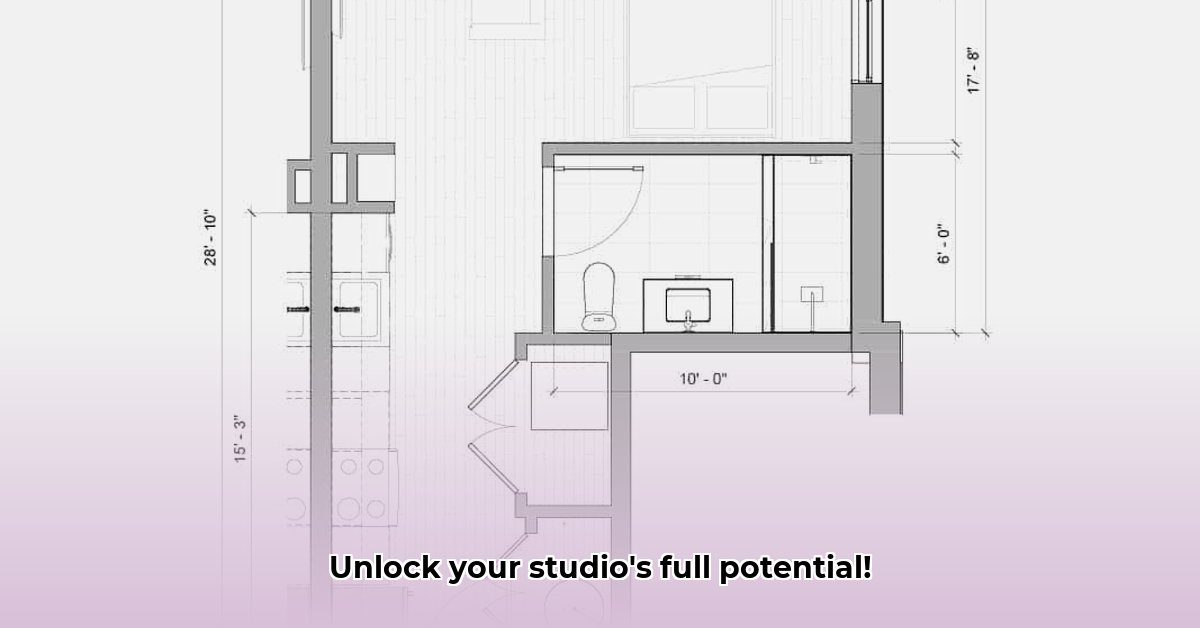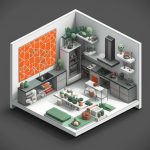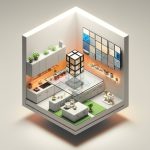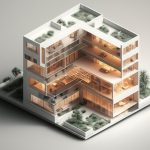Studio apartments present unique design challenges and exciting opportunities. This guide provides actionable strategies to transform your limited square footage into a stylish, highly functional living space, covering furniture choices, storage solutions, and simple design tricks. For more floor plan inspiration, check out these apartment floor plans.
Studio Floor Plans: Clever Design and Space Maximization
Transforming a small studio apartment into a comfortable and functional haven requires creativity, meticulous planning, and understanding key design principles. This guide offers practical tips to turn cramped quarters into a cozy and efficient living space that reflects your personal style. Successfully optimizing your studio floor plan involves clever use of light, space, and versatile furnishings.
Understanding Studio Apartment Design Principles: Light, Space, and Versatility
Smart design is the cornerstone of a successful studio apartment. Effective design principles center around optimizing natural light, utilizing vertical space, implementing strategic zoning, and incorporating multifunctional furniture to create a space that feels both airy and spacious. Positioning furniture to maximize natural light, such as keeping window areas clear, and utilizing vertical space with tall bookshelves and hanging organizers are key elements. Employing multifunctional furniture, such as sofa beds, storage ottomans, and nesting tables can further enhance space efficiency and adaptability.
Space Optimization Strategies for Your Studio Apartment
Maximize your limited space using actionable techniques to create a studio you’ll love. The goal is to maximize every square inch of your studio apartment.
-
Furniture Selection: Embrace multi-tasking furniture like storage ottomans that serve as coffee tables or seating, and Murphy beds that fold away to free up floor space during the day. These pieces provide dual functionality, maximizing utility without sacrificing precious space. Look for expandable dining tables that can be tucked away when not in use.
-
Storage Solutions: Utilize vertical space with tall, narrow bookshelves to house books, decor, and storage bins. Employ under-bed storage containers to keep seasonal clothing, linens, and other items organized and out of sight. Consider floating shelves to keep floor space clear.
-
Light and Color: Employ light, neutral colors on walls and larger furniture pieces to amplify light and create the illusion of spaciousness. Strategically placed mirrors, particularly opposite windows, can further enhance the sense of openness. Sheer curtains allow natural light to filter in while maintaining privacy.
-
Zoning Techniques: Define separate areas for living, sleeping, and working using rugs, curtains, screens, or shelving units to create distinct zones within the open space. Use these dividers to establish functional areas without permanently altering the layout. Plants can also serve as natural dividers, adding a touch of greenery and privacy.
Case Studies: Real-World Studio Apartment Success Stories
Examine successful studio apartment designs that have effectively overcome space challenges. One example showcases a platform bed with built-in drawers, optimizing under-bed storage, while floor-to-ceiling curtains define a sleeping area, highlighting design choices that enhance both functionality and aesthetics. Another design features a kitchen island that serves as a breakfast bar, workspace, and additional storage, transforming a functional area into a focal point. Consider how these designs address common studio apartment challenges and adapt these concepts to your space.
Tailoring Your Studio Apartment to Your Unique Needs
Your studio should reflect your individual lifestyle, whether you’re a single professional, a couple, or a student. A single person might value ample closet space and a large desk, while a couple might need a distinctly defined sleeping and living area. If you work from home, prioritize a dedicated workspace with proper lighting and ergonomic furniture. If you enjoy entertaining, focus on creating a comfortable and inviting living area.
Budget-Friendly Design: Making it Work Without Breaking the Bank
Creating a stylish and functional studio doesn’t require excessive spending. Explore budget-friendly options like gently-used furniture from thrift stores or online marketplaces, DIY storage solutions using repurposed materials, and affordable decor items. Look for sales and discounts on furniture and home goods.
Final Thoughts: Unleash Your Studio’s Potential
Turn your studio apartment into a triumph by implementing these strategies, making it a reflection of your creativity and design skills. With smart planning, resourcefulness, and a keen eye for detail, you can create a space that truly feels like home, regardless of its size.
How to Maximize Storage in a Small Studio Apartment
Key Takeaways:
- Decluttering increases openness in your studio apartment.
- Vertical space maximizes storage potential.
- Multi-functional furniture provides multiple uses.
- Light colors and mirrors expand your space visually.
- Zoning techniques visually delineate areas.
- Budget-friendly options exist for storage solutions.
- Wall-mounted solutions keep floorspace open.
Understanding Studio Apartment Design Principles: Space and Light
Limited square footage necessitates creative space utilization, transforming cramped areas into functional and stylish havens through optimized natural light, strategic zoning using rugs and curtains, and multi-functional furniture like sofa beds and ottomans with storage. Maximize natural light by keeping windows clear of obstructions and using sheer curtains.
Space Optimization Strategies for Small Studio Apartments
This section focuses on how to maximize storage in a small studio apartment.
-
Furniture Selection: Choose ottomans with hidden compartments and beds with drawers to maximize storage. Opt for modular shelving units that can be customized to fit your space. Consider a coffee table with a lift-top to create a hidden workspace or dining surface.
-
Clever Storage Solutions: Utilize under-bed storage containers to store out-of-season clothing or extra linens. Hang items on hooks or wall-mounted racks to keep your room organized and free up floor space. Use over-the-door organizers to store shoes, accessories, and toiletries.
-
Visual Tricks: Use light colors and mirrors to create the illusion of more space, enhancing brightness and airiness. Arrange mirrors strategically to reflect light and create depth. Use vertical stripes to make walls appear taller.
-
Zoning Techniques: Use area rugs and room dividers to define living areas, creating visual separation and distinct zones for different activities. Use plants or screens as dividers to add privacy and visual interest. Consider painting different zones in complementary colors to enhance the sense of separation.
Addressing Specific Needs for Studio Apartment Storage
The strategies for how to maximize storage in a small studio apartment will vary based on lifestyle and needs, requiring tailored solutions for singles, couples, and students to optimize space and storage efficiently. If you have a large wardrobe, consider a clothing rack with shelves to maximize vertical storage. If you enjoy cooking, invest in storage containers to keep your pantry organized.
Budget Considerations for Studio Apartments
Many affordable solutions exist for how to maximize storage in a small studio apartment. DIY storage solutions and thrift store finds offer practical and stylish options. Look for sales and discounts on storage containers, shelves, and other organizational items. Repurpose old furniture and containers to create unique and affordable storage solutions.
Studio Apartment Design for Remote Workers: Optimizing Space and Productivity
Key Takeaways:
- Leveraging vertical space with floor-to-ceiling shelving enhances storage and visual appeal.
- Multifunctional furniture maximizes space efficiency and adaptability.
- Strategic zoning defines areas within the open plan for work and relaxation.
- Mirrors and light colors visually expand the space, creating a brighter environment.
- Adaptable designs cater to remote work needs, promoting productivity and comfort.
- Budget-friendly options are available for furniture and storage.
Understanding Studio Apartment Design Principles
Maximizing a limited footprint involves intelligent design that prioritizes natural light through window treatments, strategic zoning using rugs and lighting, and multi-functional furniture, such as sofa beds and foldable desks. Optimize natural light by positioning your workspace near a window and using adjustable task lighting.
Space Optimization Strategies
Here’s how to transform your studio into a productive haven for remote work.
-
Vertical Space: Utilize floor-to-ceiling shelving for maximizing storage and showcasing decor. Install floating shelves above your desk to keep work essentials within easy reach. Use wall-mounted organizers to store office supplies and keep your desk clutter-free.
-
Furniture Selection: Incorporate Murphy beds and wall-mounted desks to save space and create a dedicated workspace that can be easily concealed when not in use. Choose an ergonomic chair that provides proper support for long hours of work. Consider a standing desk converter to alternate between sitting and standing throughout the day.
-
Storage Solutions: Utilize under-bed storage containers and slim shelving units for vertical storage. Use clear storage bins to easily identify the contents and keep your belongings organized. Consider a storage ottoman to store blankets or pillows for quick access during breaks.
-
Mirrors and Light Colors: Position mirrors to create the illusion of more space and enhance natural light. Paint your walls in light, neutral colors to create a bright and airy atmosphere. Use sheer curtains to filter natural light and maintain privacy.
-
Zoning Techniques: Delineate zones using rugs, different lighting levels, and strategically placed furniture. Use a room divider or screen to create a visual separation between your workspace and living area. Add plants to create a calming and inviting atmosphere in your workspace.
Case Study: Maximizing a 400 sq ft Studio
A 400-square-foot studio apartment maximizes space with a loft bed, cleverly designed workspace, and convertible sofa, resulting in a functional area much larger than it is, embodying Studio Apartment Design for Remote Workers: Optimizing Space and Productivity. The lofted bed creates additional floor space for a dedicated workspace, while the convertible sofa provides a comfortable seating area for breaks and relaxation.
Addressing Specific Needs
Design choices should reflect individual needs. For example, single occupants need comfortable workspaces and ample storage, while couples
- Gray Kitchen Backsplash Ideas: Find Your Perfect Gray Tile - December 11, 2025
- Glass Wall Tiles For Bathroom: A Stylish, Durable Choice - December 10, 2025
- Glass Mosaic Kitchen Backsplash: Add Shimmer and Style - December 9, 2025









